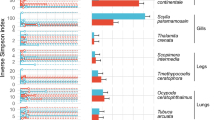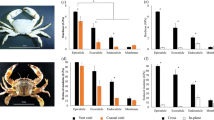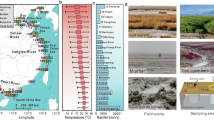Abstract
Sand-bubbler crabs, Scopimera and Dotilla (Crustacea, Brachyura, Ocypodidae, Scopimerinae), are small (carapace width 1 cm) round-bodied crabs which occur in vast numbers throughout the Indo-Pacific on suitable tropical and sub-tropical sheltered sandy beaches. At high tide they are found in burrows that contain a trapped pocket of air in which the crabs are able to breathe until low tide. During low tide they become active and emerge from their burrows to feed on surface detritus and stranded plankton1–3. One of the most striking, and unique, features of these crabs is the presence of large membranous disks (‘tympana’) on the meral segments of the legs (Fig. 1) and sometimes (in Dotilla) on the thoracic sterna3. Although in 1893 Aurivillius suggested that the membranes might be used for hearing4, their function has remained unknown. Here I present evidence which suggests that, rather than being auditory organs, the tympana are primarily respiratory structures used in aerial gas exchange. As the generic name Scopimera means "thighs with windows in them"5, I have coined the term ‘gas windows’ for these membranes.
This is a preview of subscription content, access via your institution
Access options
Subscribe to this journal
Receive 51 print issues and online access
$199.00 per year
only $3.90 per issue
Buy this article
- Purchase on SpringerLink
- Instant access to full article PDF
Prices may be subject to local taxes which are calculated during checkout
Similar content being viewed by others
References
McCulloch, A. R. & McNiell, F. A. Rec. Aust. Mus. 14, 49–59 (1923–1926).
Hartnoll, R. G. Estuar. coast. mar. Sci. 1, 137–152 (1973).
Kemp, S. Rec. Indian Mus. 16, 305–348 (1919).
Aurivillius, C. W .S., Nova Acta R. Soc. Scient. Upsal Ser. 3 16, 1–43 (1893).
de Haan, W. in Fauna Japonica (ed. de Siebold, Ph. Fr.) 24–25 (J. Muller & Sons, Amsterdam, 1833–1850).
Greenaway, P. & Farrelly, C. A. J. Morph. 181, 133–142 (1984).
Maynard, D. M. The Physiology of Crustacea Vol. 1, 161–226 (Academic, London, 1960).
Storch, V. & Welsch, U. Mar. Biol. (Berl.) 29, 363–371 (1975).
von Raben, K. Z. wiss. Zool. 145, 425–461 (1934).
Taylor, H. H. & Greenaway, P. J. Zool. 189, 359–384 (1979).
Greenaway, P., J. Zool. 32, 1–6 (1984).
Umbreit, W. W., Burris, R. H. & Stauffer, J. F. Manometric and Biochemical Techniques 5th edn (Burgess, Minnesota, 1972).
Diaz, H. & Rodriguez, G. Biol Bull mar biol. Lab., Woods Hole 153, 485–504 (1977).
Author information
Authors and Affiliations
Rights and permissions
About this article
Cite this article
Maitland, D. Crabs that breathe air with their legs-Scopimera and Dotilla. Nature 319, 493–495 (1986). https://doi.org/10.1038/319493a0
Received:
Accepted:
Issue date:
DOI: https://doi.org/10.1038/319493a0
This article is cited by
-
Gill-associated bacteria are homogeneously selected in amphibious mangrove crabs to sustain host intertidal adaptation
Microbiome (2023)
-
Species-specific gill’s microbiome of eight crab species with different breathing adaptations
Scientific Reports (2023)
-
Effects of emersion on acid–base regulation, osmoregulation, and nitrogen physiology in the semi-terrestrial mangrove crab, Helice formosensis
Journal of Comparative Physiology B (2021)
-
Anatomy of structures associated with air-breathing in Orchestia gammarellus (Crustacea: Amphipoda: Talitridae): coxal plates and gills
Marine Biology (1996)



